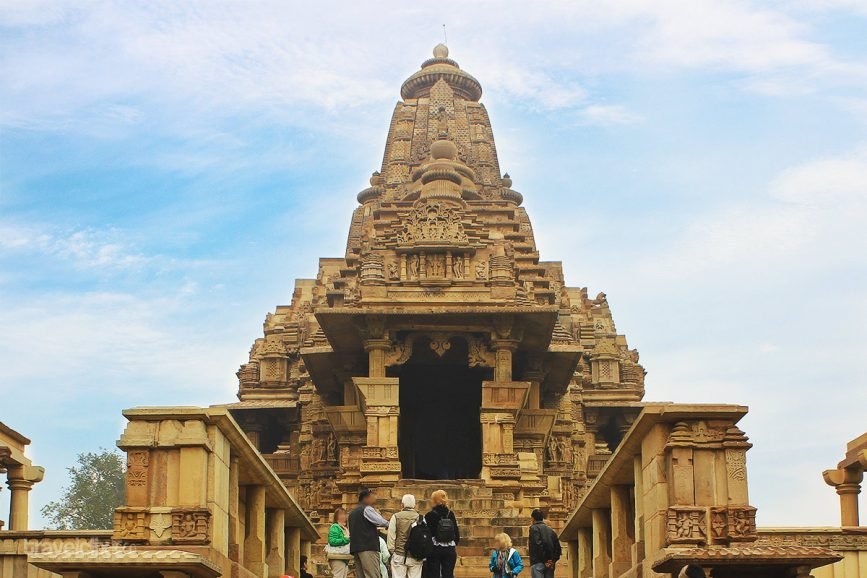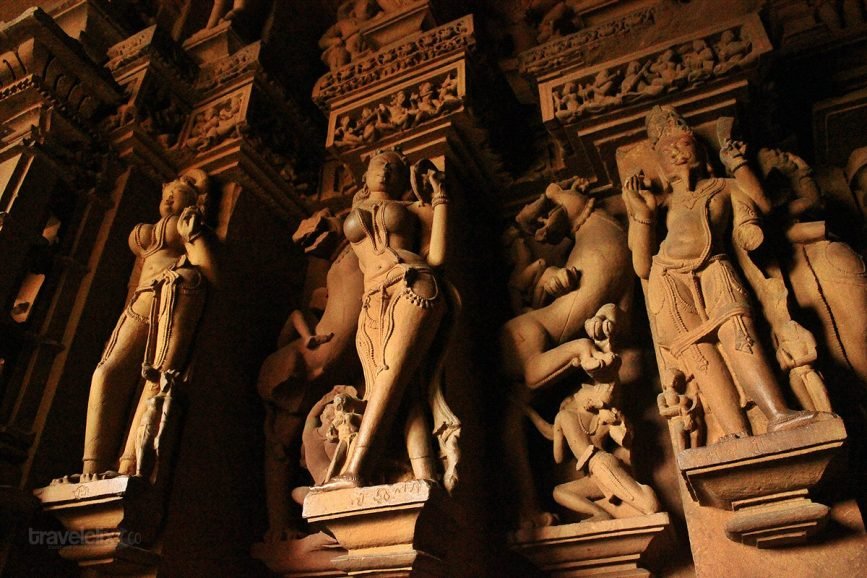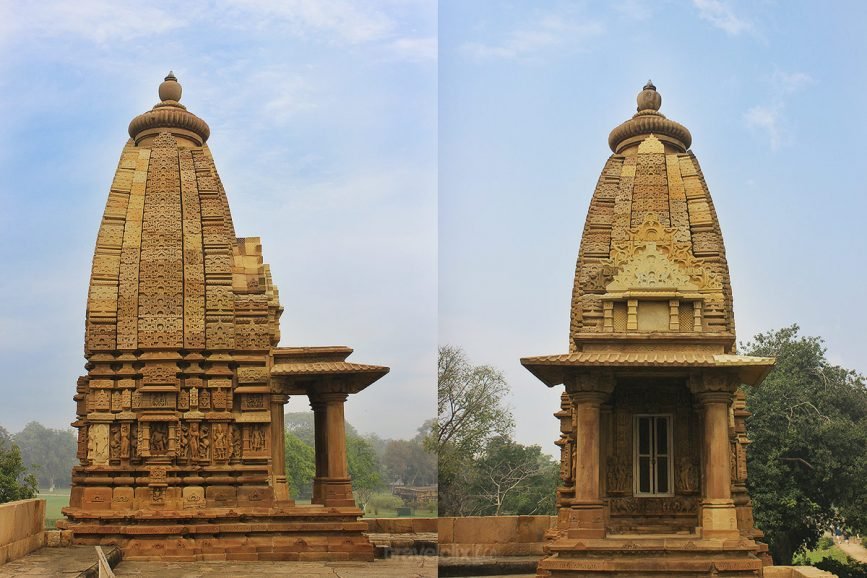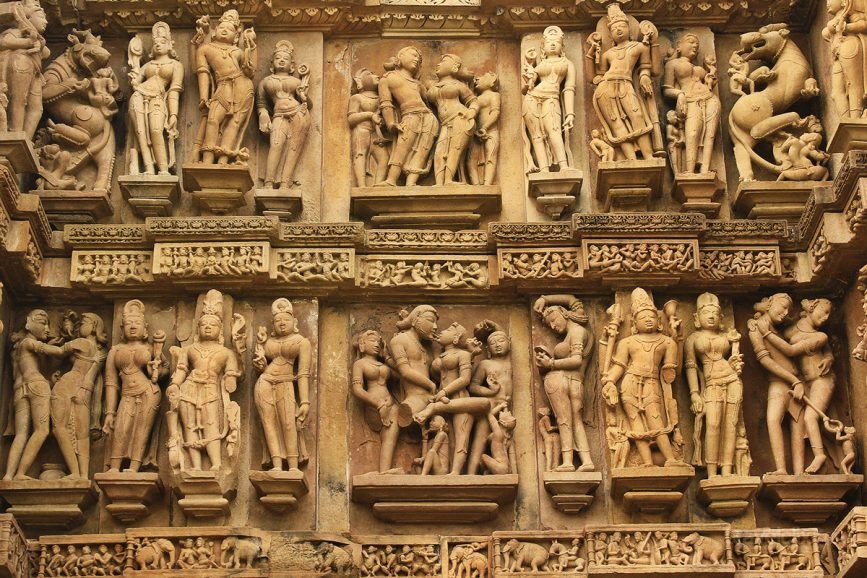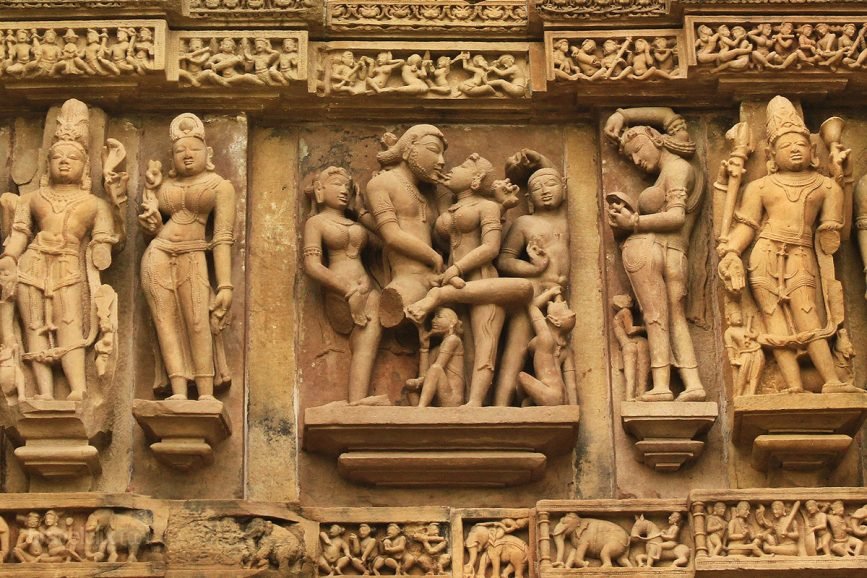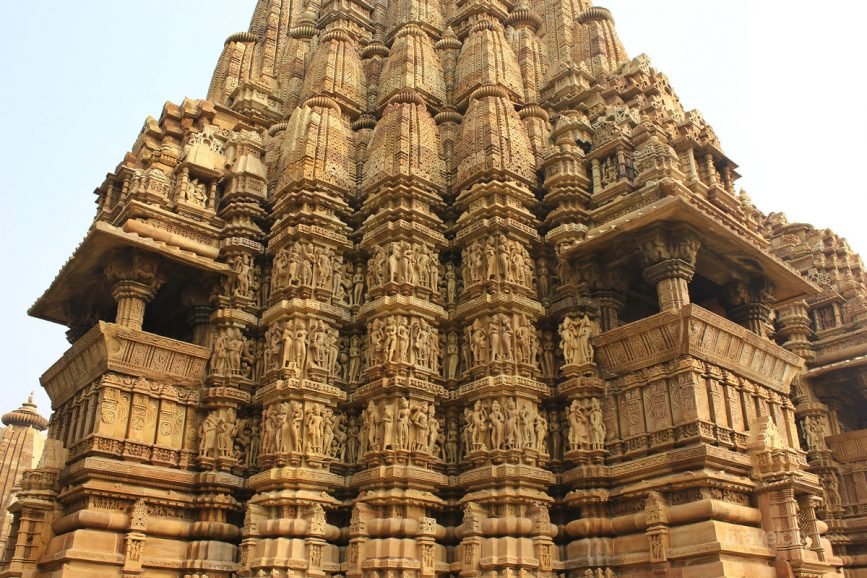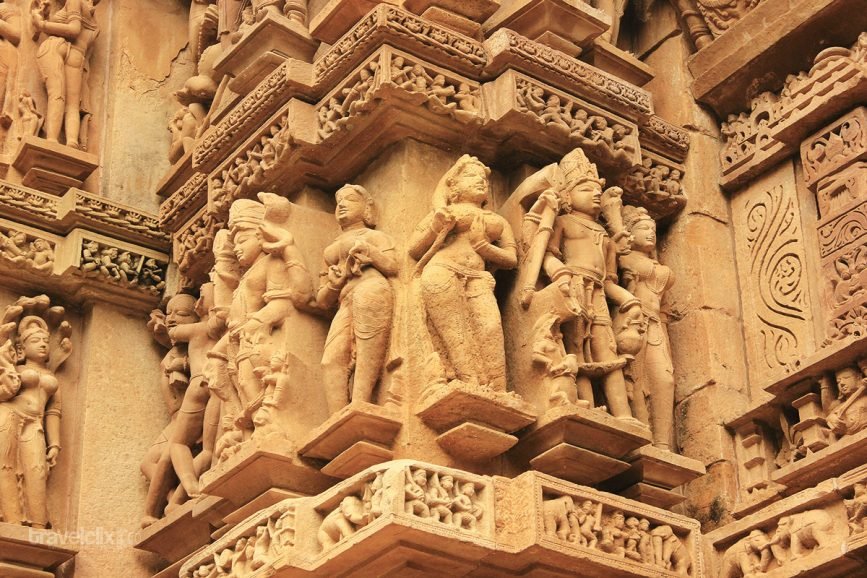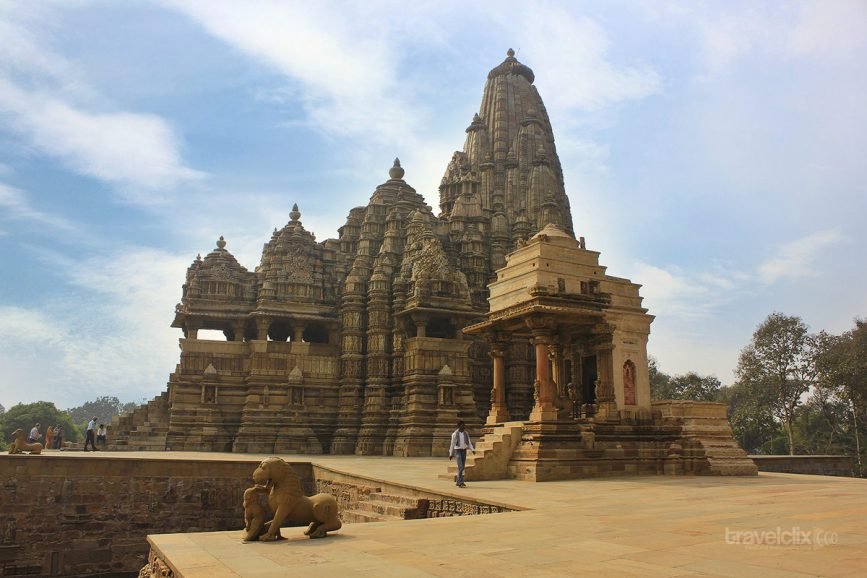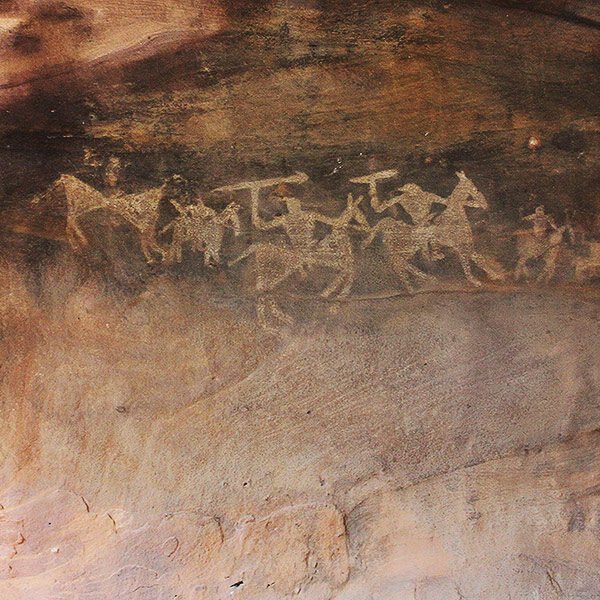Ancient Indian temples and its architecture are very famous worldwide. We are going to see one of the best groups of temples at Khajuraho in India. Khajuraho Group of Monuments is a group of Hindu temples and Jain temples. It is one of the many
UNESCO World Heritage sites in India.
The Celebration of Life is Creatively Played Out On It’s Walls
Khajuraho is one of the most popular tourist destinations in Central India. Khajuraho is located in Chhatarpur district of Madhya Pradesh. In modern times, Khajuraho is mainly hyped for its Erotic Sculptures, that are carved out on the outer walls of the temples. However, Khajuraho temples are beyond just erotics and love temples but the knowledge base of everyday life in medieval times. Whereas Erotic sculptures are just a part of that, merely around 8% – 10% of all sculptures. The celebration of life is creatively played out on the exteriors of the temples.
Temples of Khajuraho are consists of different figures like Devtas, Apsara, Sur-Sundaries, Animals, Musicians, Dancers and Erotic Couples or Groups. According to the local credence, Khajuraho had 85 temples spread over the city. However, only 25 temples have survived with some restoration work. Based on Khajuraho temples geographical location,
they are categorized into three groups:
- Eastern Temples
- Western Temples
- Southern Temples
We are going to glance over some of the temples from Western Group in this post. Western Group of Temples are the most visited by tourists from across the globe.
Passing the entrance gate, you will be amazed to see the well-maintained garden and temples structures distributed over that area. Moving further, on your left front, you will see a small group of temples, Lakshman Temple, Lakshmi Temple, Varah Temple & Matangeshwar Temple.
Khajuraho: Lakshman Temple
Lakshman temple is dedicated to God Vishnu. It is built by King Yasovarman also known as Lakshavarman and hence the temple derives it’s named from him. Lakshmana temple was said to be the most ornate and evolved temple of its age in central India. It is best preserved in the evolved temples. This Vaishnava temple is a Sandhara Temple (संधार पद्धती) of the Panchaayatan (पंचायतन)(Five Shrined) layout. Sandhara temples are those which does have a Pradakshina Path. Pradakshina path is a track around the temple shrine, which is used for walking in the right direction–that is circling the shrine–as a mark of respect.
The prime shrine is surrounded by four subsidiary shrines in four corners at Lakshman Temple. According to Panchaayatan (पंचायतन), the prime shrine is accompanied by 4 small shrines on its 4 corners. Those 4 shrines are dedicated to five different deities i.e. Vishnu, Shiv, Surya, Ganesh & the Goddess. All these shrines are worshiped simultaneously.
As you enter into the prime shrine and proceed towards Garbh Gruh (Sanctum), there is an idol of the deity i.e. God Vishnu. The idol has three faces, where the left face is of Narsinh or Narasimha Avtaar (Human Body With Lion Face), Central is a Human Face and the Right face is a Varah Avtaar (Boar). The Surya (Sun) is carved out behind these faces. The idol is with broken hands, hence the daily worship does not take place in this temple.
Temple is constructed facing east direction as per the principles of Vastu Shastra (Science of Architecture). Therefore, when the sun rises, the light falls directly on the idol. During the progress towards the west(Sunset), the sunlight is reflected from the temples–that are facing towards the prime shrine–on the platform and then reflected directly towards the main idol. This way the temple is always brightened by the natural light. There is a stone inscription at the entrance. The inscription uses Sanskrit language and the script of this language is Devnagari. The inscription conveys the information regarding the temple, like the king who built it and when it was built, etc.
Khajuraho: Mahalaxmi Temple
Next to lakshaman Temple, there was a Garud Temple. A temple dedicated to Garud (Eagle) which is God Vishnu’s Vahan. However, when the restoration work began for this temple, the idol of Mahalakshmi was installed in this temple. Mahalakshmi is a consort of God Vishnu.
Khajuraho: Varah Temple
This temple dedicated to the 3rd avatar of God Vishnu, Varah Avtaar. A temple erected on 14 pillars and a spire on the top. The temple idol Carved in a single stone and is of approx 2.5 meters long and over 1.5 meters high. The material used in building this giant idol looks like a metal(Bronze like) due to its finishing, but it’s carved out from a sandstone.
There’s an interesting reason behind this bronze-like finishing on a sandstone. Local’s during medieval times (and still today) used to believe that when they perform Pradakshinaa (Circumambulation) around the idol, touching the idol with their hands, the positive energy possessed by the idol will be transformed into them. Hence it became customary for devotees to touch the idols during Pradakshina. So this energy receiving belief for over the centuries caused the glossy shining on a sandstone.
This Varah idol is festooned with figures of gods, goddesses and apsaras counting nearly 674 as told by our guide. There is also Sheshnaag(Snake God) depicted in a devotional posture under the Varah Idol(boar) on the pedestal. And a figure of Saraswati Goddess(Goddess of Knowledge) is carved on the nose on the front side.
Khajuraho: Matangeshwar Temple
Adjacent and on the right side of the Lakshman Temple, stands Matangeshwar Temple separated from Lakshman Temple and other adjacent temples. The reason for separation is, this is the only temple in the Western Group of Temples, which is worshiped every day by locals and tourists. All the other temples are in dilapidated state and worship is no longer conducted. This temple–compared to other temples in this group–is less decorated with figures of gods and goddesses.
Erotic Sculptures of Khajuraho
Khajuraho Temples clearly depict the cultural life of the society on the exteriors of the temples. Society during medieval times is considered to be the most liberal and tolerant society. According to some references in the books, Khajuraho temples also considered as Non-Family destinations, due to the presence of Erotic Sculptures. If you look at these sculptures as an ART, then you’ll be amazed by the finest skills of sculptors. Even though these sculptures cover 8% – 10% of all sculptures in Khajuraho, they still hold the viewers’ attention and this is what makes Khajuraho Temples so special.
These sculptures have lent themselves to various interpretations. Some interpretations express the possibility of building these temples due to the fall in moral values in contemporary society. Some regard them to Tantrism and believe that Trantrics used to live on these lands. Whereas, some of the interpretations who has a philosophical base, says this is one of the ways to attain Moksh (Salvation) and then some other interpretations consider them as the illustrations of erotic postures mentioned in the ancient texts of Kamashastra.
The place which turns a tourist into a Photographer 😉 with its Grandeur and Magnificence.
It has also been suggested that these scenes represent the erotic practices of certain medieval Indian sects. These practices invested the sexual act with a ritual symbolism and considered Yog (Spiritual Exercise) and Bhog (Physical Pleasure) to be alternate paths leading to the attainment of final deliverance. According to these sects, the controlled enjoyment of senses was an easier way of salvation.
Khajuraho: Kandariya Mahadev Temple
Moving further from Lakshman temple, on back side you will see Kandariya Mahadev temple. The Chandella kingdom reached its apex under the rule of King Vidyadhar (c.1017-29 -The successor of King Gandha). King Vidyadhar also continued the tradition of building temples just like his forefathers. The authorship of the Kandariya-Mahadev temple is attribued to King Vidyadhar.
Kandariya-Mahadev temple is the largest and grandest temple of Khajuraho.
This temple is dedicated to God Shiv and a shivling (made of marble) is installed in later times. At the entrance, you will see beautiful Makar toran and above it God Shiv with Goddess Parvati.
There are numerous sculptures of Apsaras & Sur-Sundaris in Khajuraho temples. Sur-Sundaris are represented invariably in the finest jewellery and in superior garments. They also show different moods and emotions. Some moods shows disrobing, yawning, touching their breasts and removing thorns from their feet. Whereas, Apsaras are shown in various dancing poses.
Khajuraho: Nagara or Northern Style Architecture
Nagar or Northern Style Architecture is used to construct these Khajuraho Temples. The aspects of this particular style are focussed on a square-shaped sanctum with a curvilinear Spire on top of the building. All temples in Khajuraho–except a few temples–are made of fine-grained sandstone and mostly in pale yellow color which resembles the skin color tone of an Indian.
Sculptures
According to ASI (Archeological Survey of India) book, Khajuraho sculptures can be divided in to five broad categories:
- First category consist of formal cult-images.
- Second category consist of Parivara, Parsva and Avarana-devtas (family, attendant and enclosing divinities) which mostly seen in niches.
- Third category consist of Apsaras and Sura-Sundaris.
- Fourth category consist of domestic scenes, teachers and disciples, dancers and musicians and erotic couples or groups.
- Fifth category consist of sculptures of animals including mythical Vyal or Shardul, the beast often represented as a rampant horned lion with an armed human rider on its back.
Thank you for checking our Blog post
Khajuraho Travel Guide:
How to Reach (As per MP tourism website)
- By Air: Khajuraho Civil Aerodrome is located about 2 km from the town centre and is well connected to cities like Delhi, Mumbai, Hyderabad, Varanasi and Indore
- By Train: You can get to Khajuraho in a train by getting off at the Khajuraho Railway Station, which is around 5 km from the main town centre. The station is well connected to Delhi and Varanasi and (via Satna Railway Station) to Mumbai and Kolkata.
- By Road: Khajuraho is connected by road to cities like Jhansi, Orchha, Bandhavgarh and Chattarpur. You can hire a taxi from any of these places to get to the city.
Best Time to Visit
You can visit throughout the year but best time is September To February
Open Timings
It is open from 8.00AM to 6.00PM
The Khajuraho Temple Light & Sound Show Timings
The light and sound show is organised in the Western group complex by the Madhya Pradesh Tourism Department. It is in two languages: English and Hindi. The timings for these shows are different for winters and summers.
- October to February: 6:30PM. to 7:25PM for English and 7:40PM to 8:35PM for Hindi.
- March to September: 7:30PM. to 8:25PM for English and 8:40PM to 9:35PM for Hindi.
The entry fee for the show is: Indian visitors – Rs 250 and Foreigners – Rs 700. There is no entry ticket for children below 5 years.
Note: Information of pricing/timing given here may change so please confirm with tourism department before visiting.
History of Khajuraho Group of Monuments
As per ASI – Archeological Survey of India:
First recorded mention of the Khajuraho temple is in the accounts of Abu Rihan al Biruni (AD 1022) and the Arab traveler Ibn Battuta (AD 1335). Khajuraho was known as Kharjjuravahaka in ancient time. Khajuraho was Cultural capital of the Chandella Dynasty. Chandella rulers were great patrons of ART and architecture. Chandella rulers built these temples in between AD 900 and AD 1130. They ruled over Jejakabhukti presently known as Bundelkhand.
First notable Chandella prince was Harsha. Harsha’s son and succesor Yashovarman also known as Lakshavarman. According to different Khajuraho inscriptions:
- Lakshvarman built Lakshmana Temple
- Lakshvarman was succeeded by his son Dhanga (c950-1002) who built the Visvanatha and the Parshvanatha temples.
- Dhanga’s son Ganda (c.1002-17) built the Jagadambi and Sun Temple now known as Chitragupta Temple.
- Ganda’s son Vidyadhar (c.1017-29) built the largest and grandest temple in Khajuraho called Kandariya Mahadev Temple.
After Vidyadhar, the power of chandella dynasty gradually declined. The importance of Khajuraho dwindled. Later rulers increasingly concentrated on hill forts of Mahoba, kalinjar and Ajaygadh for strategic reasons. However, the artistic momentum of Khajuraho was not lost and the temples continued to be built here till the 12th century. Kandariya- Mahadev temple was followed by a succession of smaller but almost equally artistic temple such as Vamana, Adinatha, Javari, chaturbhuja, duladeo. Arab traveller Ibn Battuta reveals that the Khajuraho temple continued to shine in Glory till 1335.
The temple town sank from public consciousness soon after the chandella dynasty expired in the 13th century. These temples remained lost till 1838 when T. S. Burt–a British Engineer–heard of it from his palkywallah. Burt then ventured in to the forest in search of the wonders of a place called Khajrao.
After India independence, ASI maintained and preserved these temples. In 1986, Khajuraho was listed as UNESCO’s World Heritage Sites in India.
Relative Books
Khajuraho by Archaeological Survey of India.
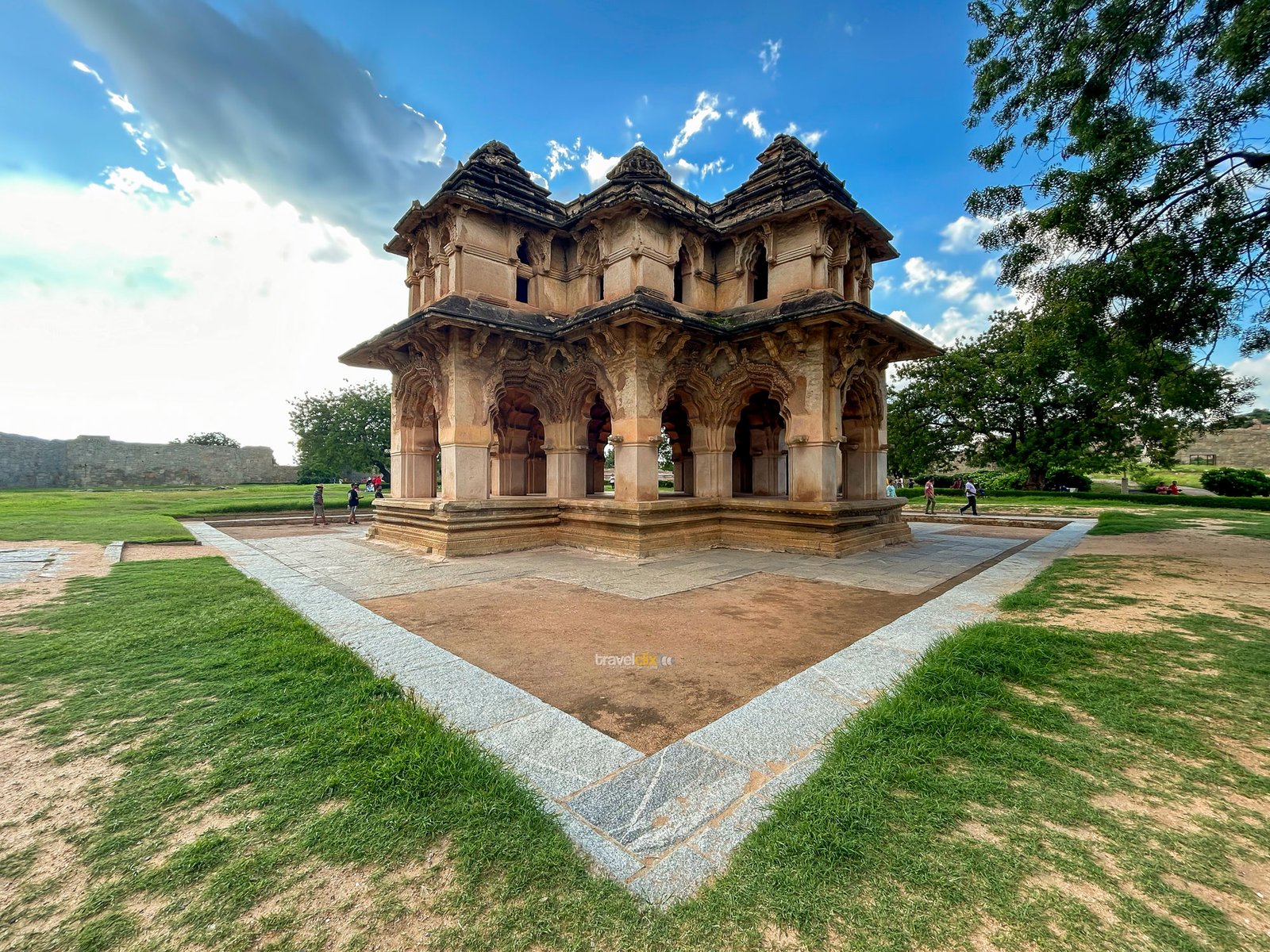
 Vernal Hanging Parrot
Vernal Hanging Parrot Pench - Introduction
Pench - Introduction Pench - Safari In The Rain
Pench - Safari In The Rain Lothal - Harappa Port Town
Lothal - Harappa Port Town Tadoba Diaries – An Unforgettable Day
Tadoba Diaries – An Unforgettable Day Khajuraho Group of Monuments
Khajuraho Group of Monuments


